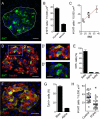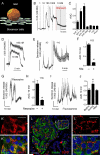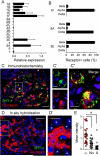Human Beta Cells Produce and Release Serotonin to Inhibit Glucagon Secretion from Alpha Cells
- PMID: 28009296
- PMCID: PMC5217294
- DOI: 10.1016/j.celrep.2016.11.072
Human Beta Cells Produce and Release Serotonin to Inhibit Glucagon Secretion from Alpha Cells
Abstract
In the pancreatic islet, serotonin is an autocrine signal increasing beta cell mass during metabolic challenges such as those associated with pregnancy or high-fat diet. It is still unclear whether serotonin is relevant for regular islet physiology and hormone secretion. Here, we show that human beta cells produce and secrete serotonin when stimulated with increases in glucose concentration. Serotonin secretion from beta cells decreases cyclic AMP (cAMP) levels in neighboring alpha cells via 5-HT1F receptors and inhibits glucagon secretion. Without serotonergic input, alpha cells lose their ability to regulate glucagon secretion in response to changes in glucose concentration, suggesting that diminished serotonergic control of alpha cells can cause glucose blindness and the uncontrolled glucagon secretion associated with diabetes. Supporting this model, pharmacological activation of 5-HT1F receptors reduces glucagon secretion and has hypoglycemic effects in diabetic mice. Thus, modulation of serotonin signaling in the islet represents a drug intervention opportunity.
Keywords: alpha cell; beta cell; diabetes; glucagon secretion; insulin secretion; pancreatic islet; paracrine signal; serotonin.
Published by Elsevier Inc.
Figures






Similar articles
-
Somatostatin and insulin mediate glucose-inhibited glucagon secretion in the pancreatic α-cell by lowering cAMP.Am J Physiol Endocrinol Metab. 2015 Jan 15;308(2):E130-43. doi: 10.1152/ajpendo.00344.2014. Epub 2014 Nov 18. Am J Physiol Endocrinol Metab. 2015. PMID: 25406263 Free PMC article.
-
β Cell tone is defined by proglucagon peptides through cAMP signaling.JCI Insight. 2019 Mar 7;4(5):e126742. doi: 10.1172/jci.insight.126742. eCollection 2019 Mar 7. JCI Insight. 2019. PMID: 30720465 Free PMC article.
-
Paracrine regulation of glucagon secretion: the β/α/δ model.Am J Physiol Endocrinol Metab. 2016 Apr 15;310(8):E597-E611. doi: 10.1152/ajpendo.00415.2015. Epub 2016 Feb 2. Am J Physiol Endocrinol Metab. 2016. PMID: 26837808 Free PMC article.
-
K(ATP)-channels and glucose-regulated glucagon secretion.Trends Endocrinol Metab. 2008 Oct;19(8):277-84. doi: 10.1016/j.tem.2008.07.003. Epub 2008 Sep 2. Trends Endocrinol Metab. 2008. PMID: 18771934 Review.
-
Regulation of islet glucagon secretion: Beyond calcium.Diabetes Obes Metab. 2018 Sep;20 Suppl 2(Suppl 2):127-136. doi: 10.1111/dom.13381. Diabetes Obes Metab. 2018. PMID: 30230183 Free PMC article. Review.
Cited by
-
Conflicting Views About Interactions Between Pancreatic α-Cells and β-Cells.Diabetes. 2023 Dec 1;72(12):1741-1747. doi: 10.2337/db23-0292. Diabetes. 2023. PMID: 37983524 Free PMC article. Review.
-
Single-Cell RNA-Seq Reveals that CD9 Is a Negative Marker of Glucose-Responsive Pancreatic β-like Cells Derived from Human Pluripotent Stem Cells.Stem Cell Reports. 2020 Nov 10;15(5):1111-1126. doi: 10.1016/j.stemcr.2020.09.009. Epub 2020 Oct 22. Stem Cell Reports. 2020. PMID: 33096048 Free PMC article.
-
Exploring the Role of Serotonin as an Immune Modulatory Component in Cardiovascular Diseases.Int J Mol Sci. 2023 Jan 12;24(2):1549. doi: 10.3390/ijms24021549. Int J Mol Sci. 2023. PMID: 36675065 Free PMC article. Review.
-
Glucose controls glucagon secretion by directly modulating cAMP in alpha cells.Diabetologia. 2019 Jul;62(7):1212-1224. doi: 10.1007/s00125-019-4857-6. Epub 2019 Apr 5. Diabetologia. 2019. PMID: 30953108 Free PMC article.
-
GLP-1 suppresses glucagon secretion in human pancreatic alpha-cells by inhibition of P/Q-type Ca2+ channels.Physiol Rep. 2018 Sep;6(17):e13852. doi: 10.14814/phy2.13852. Physiol Rep. 2018. PMID: 30187652 Free PMC article.
References
-
- Anlauf M, et al. Expression of the two isoforms of the vesicular monoamine transporter (VMAT1 and VMAT2) in the endocrine pancreas and pancreatic endocrine tumors. The journal of histochemistry and cytochemistry : official journal of the Histochemistry Society. 2003;51:1027–1040. - PubMed
-
- Bennet H, et al. Altered serotonin (5-HT) 1D and 2A receptor expression may contribute to defective insulin and glucagon secretion in human type 2 diabetes. Peptides. 2015;71:113–120. - PubMed
MeSH terms
Substances
Grants and funding
LinkOut - more resources
Full Text Sources
Other Literature Sources
Medical
Molecular Biology Databases

